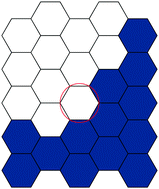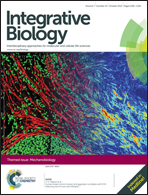Modelling wound closure in an epithelial cell sheet using the cellular Potts model†
Abstract
We use a two-dimensional cellular Potts model to represent the behavior of an epithelial cell layer and describe its dynamics in response to a microscopic wound. Using an energy function to describe properties of the cells, we found that the interaction between contractile tension along cell–cell junctions and cell–cell adhesion plays an important role not only in determining the dynamics and morphology of cells in the monolayer, but also in influencing whether or not a wound in the monolayer will close. Our results suggest that, depending on the balance between cell–cell adhesion and junctional tension, mechanics of the monolayer can either correspond to a hard or a soft regime that determines cell morphology and polygonal organization in the monolayer. Moreover, the presence of a wound in a hard regime, where junctional tension is significant, can lead to two results: (1) wound closure or (2) an initial increase and expansion of the wound area towards an equilibrium value. Theoretical approximations and simulations allowed us to determine the thresholds in the values of cell–cell adhesion and initial wound size that allow the system to lead to wound closure. Overall, our results suggest that around the site of injury, changes in the balance between contraction and adhesion determine whether or not non-monotonous wound closure occurs.

- This article is part of the themed collection: Mechanobiology

 Please wait while we load your content...
Please wait while we load your content...